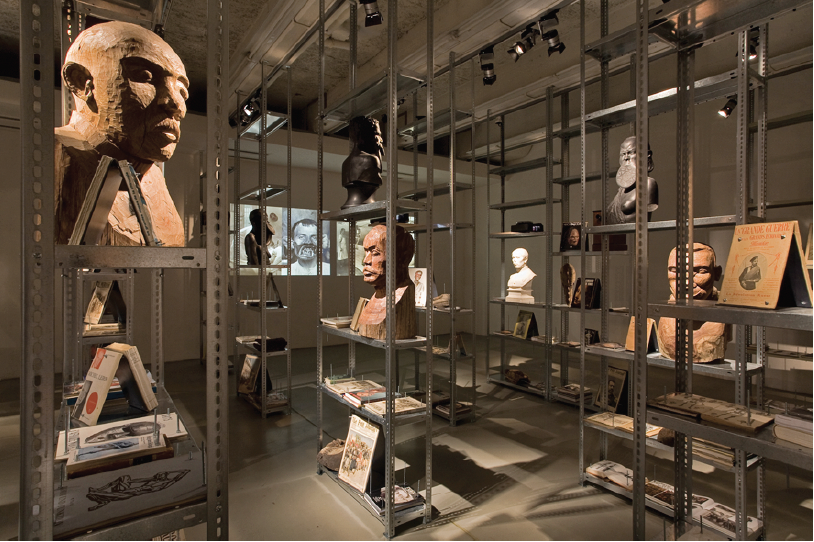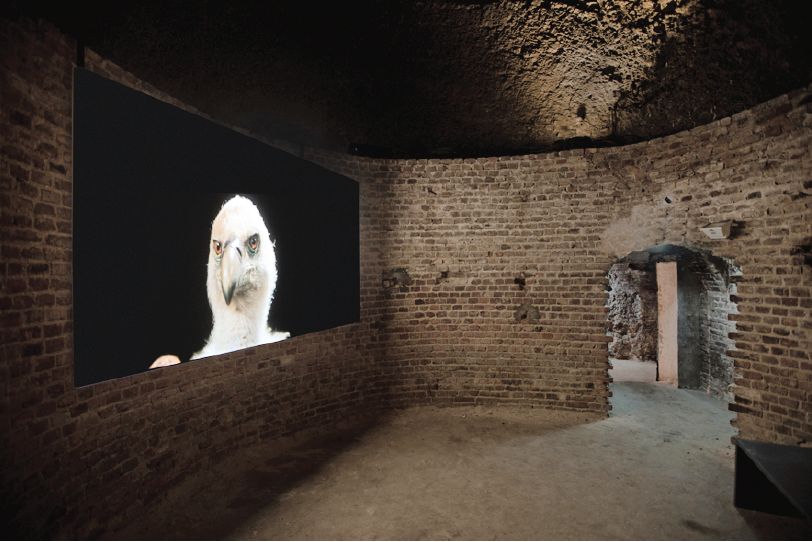“dOCUMENTA (13)”

Michael Rakowitz, What Dust Will Rise?, 2012, commissioned and produced by dOCUMENTA (13) with the support of Dena Foundation for Contemporary Art, Paris, and Lombard Freid Projects, New York. Photograph: Roman März. Courtesy the artist, Dena Foundation for Contemporary Art, Paris, and Lombard Freid Projects, New York.
Mindboggling, exhausting, a blockbuster, whatever superlative you choose for it, “dOCUMENTA (13)” stands as some kind of nirvana for denizens of the artworld. Presenting an in-depth picture of contemporary art practice with the work of 200 artists, as well as dozens of events featuring professionals from a wide range of fields—including hypnotherapists, priests and political scientists—an exhibition this big hardly lends itself to neat summation. Everyone’s experience of dOCUMENTA can’t help but be different. Recognizing this, artistic director Carolyn Christov-Bakargiev avoids stating an overall theme. Instead, as is appropriate, art finds its definition through the artworks presented, the “dOCUMENTA (13)” experience offering less bird’s-eye view of contemporary production than an arduous, if pleasurable, trek through its underbrush.
Meeting the first of numerous acquaintances I would bump into in the city, I was pointed in the direction of a work by 2010 Turner Prize winner Susan Philipsz, one of many projects located in the train station. Positioned at the far end of Track 12, the artist’s Study for Strings, 2010, presents an audio piece based on the eponymous composition by Pavel Haas that was written in the Terezín concentration camp in 1944. Fanning out on speakers arrayed across a number of the tracks, Philipsz aligns cello string with railroad track to create a doleful, layered experience of a location once used to deport Jewish families to Nazi death camps. The work offers a shimmering instance of Christov-Bakargiev’s curatorial goal to create an exhibition that presents “the shared practices of knowing of all the animate and inanimate makers of the world, including people.” Peer into the weirdness and incoherence of this sentence and you can grasp a useful idea: Demoting humans to just one element amongst others in the experience of being offers a way forward for a crisis- addicted planet in the early 21st century. Artworks are a mechanism by which we can grasp this reality. History precedes the artist and the artwork. It is art’s special task to create the circumstances through which the viewer experiences its meaning in the present.

Kader Attia, The Repair from Occident to Extra-Occidental Cultures, 2012, “The Repair”: slideshow projection and genuine artifacts from Africa “Repair as cultural anthropophagy and resistance”: video films, vitrines, artifacts from Africa and Europe, medical and military elements from World War I “Relecture”: life-size sculptures in wood and marble, plinths, dimensions variable. Commissioned and produced by dOCUMENTA (13). Photograph: Roman März. 3.
As is typical of an ambitious contemporary event, “dOCUMENTA (13)” supplements art presentations in conventional museum spaces with many off-site locations, including Kabul, Cairo, Alexandria and Banff. The “walk-in” art experience often associated with the off-site location sees perhaps its finest use at dOCUMENTA in Pierre Huyghe’s assemblage of animate and inanimate elements found in a clearing in the expansive Karlsaue Park. Composed of piles of rubble, a reclining nude sculpture with a beehive as a head and a white dog, with one leg dyed pink, running loose, the work proposed itself as “plants, animals, humans, bacteria…without culture.” To become culture-less is a lofty if not impossible ambition, but the piece did have the effect of evoking the sci-fi mise-en-scène of a post-apocalyptic world. Instead of eliminating culture, Vancouver’s Gareth Moore proposes to construct it from scratch. In residence in the park for the past year, Moore homesteads a forest enclave, constructing a place for himself to live that includes all the elements of an incipient society. Flagstone paths lead to various way stations including garden, workshed and lean-to for napping. Spiritual needs are met in a quasi temple, which, like the rest of this grand, beguiling project, attests to attention the artist has paid to vernacular modes of architecture. Herculean effort was also at work in Geoffrey Farmer’s installation of 30,000 figures cut out from the pages of Life Magazine, spanning the years 1935–85. The artist has created a delicately monumental artwork that suggests a figural double for photography’s—and latterly, the Internet’s—decontextualizations. Constructing culture from detritus is also the theme of Lara Favretto’s massive pile of scrap metal. She assembled and then removed various “sculptural” elements from it, replacing them with concrete casts, installing the originals in an adjacent building as if they were artefacts in a museum. A mental operation connects the two parts of the work, the mind finding relief in the separation of order from chaos, making this piece akin to the best conceptual artworks.

Jennifer Allora and Guillermo Calzadilla, Raptor’s Rapture, 2012, single-channel video projection with sound, media file played from a media player, 23 minutes, 30 seconds.
However overwhelming, dOCUMENTA’s organizational commitment to ensuring that massive projects are fully realized can’t fail to impress. Argentinean Adrián Villar Rojas presented roughly fashioned concrete sculptures of people and animals together with giant casts of forms that look like discarded bells or overturned flower pots, all of it strewn on the different levels of a hillside-terraced garden. The figure of the classical ruin is writ large and improbable. Nearby, in a 19th-century bunker carved into the side of the hill, the team of Allora & Calzadilla film a griffon vulture in ambiguous proximity to the white-gloved hands of a flautist. The musician, a specialist of prehistoric instruments, plays a 35,000-year-old flute made from the wing bone of one of the bird’s ancestors. While only faint sounds are emitting from the instrument, the idea of an ancient and unbroken avian lineage suggested by the buzzard sent shivers down my spine. Achieving a similarly eerie frisson was Michael Rakowitz’s use of the Kunsthalle Fridericianum to present an archive of reconstructed books representing volumes destroyed by bombing in 1941, housed in that same building. The artist presented the books in a display that included other remnants such as fragments from a meteorite and shrapnel from ammunition rounds used to destroy the Buddhas of Bamiyan statues in Afghanistan. Equally provocative in its cultural elisions was French-Algerian artist Kader Attia’s installation, which compares makeshift repairs done on African masks, the seams of each fix clearly visible, with documentation of the grotesque injuries and “repairs” endured by soldiers in WWI. Among the best-received works in the exhibition was Tino Sehgal’s group of youthful dancers performing a cappella pop songs in a darkened room. The presentation dissolves boundaries between stage and audience, as visitors inch their way around the room, walking between the performers who occasionally embrace them. For the public, the low risk of having to tentatively navigate a space in the dark offers the pleasing reward of gentle disorientation. More bracing—and widely discussed—was French choreographer Jerome Bel’s performance piece. Working with a Zurich-based troupe of mentally disabled actors, Bel had each of them, in turn, perform, not a play, but tell their own stories and perform dances they had choreographed themselves. Bordering on the confrontational, self-acknowledged as a “freak show,” the ultimate effect was humanizing. The sum of my own experience was expanded upon in ways that continue to resonate. ❚
dOCUMENTA (13), exhibited in Kassel, Germany from June 9 to September 16, 2012.
Rosemary Heather is a freelance writer and curator.

